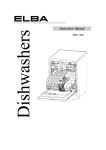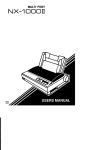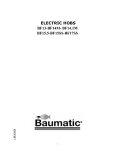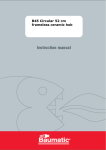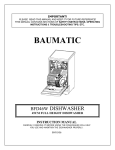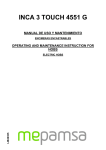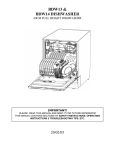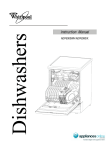Download Baumatic BFD64SS Operating instructions
Transcript
BFD64SS Dishwasher BFD64SS ..................1 This manual contains sections of Safety Instructions,Operating Instructions, Installation Instructions and Troubleshooting Tips etc. Carefully reading it before using the dishwasher will help you to use and maintain the dishwasher properly. To review the section on Troubleshooting Tips will help you to solve some common problems by yourself and not need to ask for the help of professional technicians. Control Panel . . . . . . . . . . . . . . . . . . . . . . . . 2 Dishwasher Features . . . . . . . . . . . . . . . . . 2 Wash Cycle Table . . . . . . . . . . . . . . . . . . . . 3 Turning On the Appliance . . . . . . . . . . . . . .3 Water Softener . . . . . . . . . . . . . . . . . . . . . . 4 Detergent . . . . . . . . . . . . . . . . . . . . . . . . . . . 5 Rinse Aid . . . . . . . . . . . . . . . . . . . . . . . . . 5,6 How to use the 3 in 1 program.. . . . .. ....... 6 Loading the Dishwasher Rack(14sets) . ..7 Fault codes . . . . . . . . . . . . . . . . . . . . . . . . . . 8 Filtering System . . . . . . . . . . . . . . . . . . . . ..9 Caring for the Dishwasher . . . . . . . . . . . . 10 About Electricity connection . . . . . . . . . . 10 Water Connection . . . . . . . . . . . . . . . . . . . 11 Dimensions . . . . . . . . . . . . . . . . . . . . . . . . 12 Before calling for service. . . . . . . . . . 13,14 The manufacturer, following a policy of constant development and up-dating of the product, may make modifications without giving prior notice. This appliance must be grounded. In the event of a malfunction or breakdown, grounding will reduce the risk of electric shock by providing a path of least resistance of electric current. This appliance is equipped with a cord having an equipment-grounding conductor and a grounding plug. The plug must be plugged into an appropriate outlet that is installed and grounded in accordance with all local codes and ordinances. Do not abuse, sit on, or stand on the door or dish Keep children away from detergent and rinse aid, keep rack of the dishwasher. Do not touch the heating element during or immediately after use. Do not place any heavy objects of stand on the door when it is open. The appliance could tip forward. When loading items to be washed: children away from the open door of the dishwasher, there could still be some detergent left inside. Young children should be supervised to ensure that they do not play with the appliance. The appliance is not intended for use by young children or infirm persons without supervision. Dishwasher detergents are strongly alkaline,they can be extremely dangerous if swallowed.Avoid contact with skin and eyes and keep children away from the dishwasher when the door is open. The door should not be left in the open position since this could present a tripping hazards. If the supply cord is damaged, it must be replaced by the manufacturer or its service agent or a similarly qualified person in order to avoid a hazard. Remove the door to the washing compartment when removing an old dishwasher from service or discarding it. Please dispose of packing materials properly. Use the dishwasher only for its intended function. During installation, the power supply must not be excessively or dangerously bent or flattened. Do not tamper with controls. The appliance is to be connected to the water mains using new hose sets and that old hose-sets should not be reused. The maximum number of place settings to be washed is 14. 1) Locate sharp items so that they are not likely to damage the door seal; 2) Load sharp knives with the handles up to reduce the risk of cut-type injuries. 3 ) Warning:Knives and other utensils with sharp points must be loaded in the basket with their points down or placed in a horizontal position. When using your dishwasher, you should prevent plastic item from contacting with heating element. Check that the detergent receptable is empty after completion of the wash cycle. Do not wash plastic items unless they are marked dishwasher safe or the equivalent. For plastic items not so marked, check the manufacturer's recommendations. Use only detergent and rinse additives designed for an automatic dishwasher. Never use soap, laundry detergent, or hand washing detergent in your dishwasher. Keep these products out of the reach of children. Other means for disconnection from the supply must The maximum permissible inlet water pressure is 1Mpa. be incorprated in the fixed wiring with at least 3mm The minimum permissible inlet water pressure is 0.04Mpa. contact separation in all poles. 1 There are two ways to reduce the water hardness: one way is using water softener, the other is using detergent. The hardness of the water varies from place to place. If hard water is used in the dishwasher, deposits will form on the dishes and utensils. The appliances is equipped with a special softener that uses a salt specifically designed to eliminate lime and minerals from the water. Always use salt intended for use with dishwashers. The salt container is located beneath the lower rack and should be filled as follows: 1 Remove the lower basket and then unscrew and remove the cap from the salt container. 2 If you are filling the container for the first time ,fill 2/3 of its volume with water (around 500ml). 3 Place the end of the funnel(supplied) into the hole and introduce about 1.2kg of salt .It is normal for a small amount of water to come out of the salt container 4 5 1. The salt container must be refilled when the salt warning light comes on. Though the salt container is filled 2.enough, the indicator light may not black out before the salt fully dissolves. If there are spills of the salt, a soak program could be run to wipe them out. 1 2 Unscrew the cap from the salt container. There is a ring on the container with an arrow on it (see Figure to the side), if necessary, rotate the ring in the anticlockwise direction from the "-" Setting toward the "+" sign, based on the hardness of the water being used.It is recommended that adjustments should be made in accordance with the following schema: Contact your local water board for information on the hardness of your water supply. 4 The dispenser must be refilled before the start of each wash cycle following the instructions provided in the" Wash Cycle Table".Your dishwashers use less detergent and rinse aid than conventional dishwashers. Generally, only one tablespoon of detergent is needed for a normal wash load. Also, more heavily soiled items need more detergent. Always add the detergent just before starting dishwasher, otherwise it could get damp and will not dissolve properly. To remove hard water spots, try the following: Run dishes through a normal wash program. Remove all metal dishware, such as cutlery, pans, etc., from the dishwasher. Do not add detergent. Pour two cups of vinegar into a bowl and set the bowl face up on the lower rack of the dishwasher. Run the dishes through a normal wash program. If this doesn't work, try the same process with 1 / 4 cup of citric acid crystals instead of vinegar. Use only detergent specifically made for use in dishwashers. Keep your detergent fresh and dry. Don't put powder detergent into the dispenser until You're ready to wash dishes. Dishwasher detergent is corrosive! Take care to keep it out of reach of children. The rinse aid is released during the final rinse to prevent water from forming droplets on your dishes that can leave spots and streaks. It also improves drying by allowing water to "sheet" off the dishes. Your dishwashers are designed to use liquid rinse aids. The rinse aid dispenser is located inside the door next to the detergent dispenser. To fill the dispenser, open the cap and pour the rinse aid into the dispenser until the level indicator turns completely black. The volume of the rinse aid container is about 140ml. Be careful not to overfill the dispenser, because this could cause oversudsing. Wipe away any spills with a damp cloth. Don't forget to replace the cap before you close the dishwasher door. If you have soft water, you may not need rinse aid for it may cause a white film to develop on your dishes. To open the dispenser, turn the cap to the "open" (left) arrow and lift it out. Pour the rinse aid into the dispenser, being careful not to overfill. Replace the cap by inserting it aligned with "open" arrow and turning it to the closed (right) arrow. 1 6 3 5 4 2 A measured amount of rinse aid is released during the final rinse. As with detergent, the amount of rinse aid needed for your dishes depends on the hardness of the water in your area. Too much rinse aid can result in lather of foaming and cause cloudiness or steaks on your dishes. If the water in your area is very soft, you may not need rinse aid. If you do,you can dilute the rinse aid with an equal amount of water. The rinse aid dispenser has six settings. Always start with the dispenser set on " 2 ". If spots and poor drying are problems, increase the amount of rinse aid dispensed by removing the dispenser lid and rotating the dial to "3". If the dishes still are not drying properly or are spotted, adjust the dial to the next higher number until your dishes are spot-free. We suggest you to set on "4" . 5 As the rinse aid diminishes, the size of the black dot on the rinse aid level indicator changes, as illustrated below. Full 3 / 4 full 1 / 2 full 1 / 4 full - Should refill to eliminate spotting Empty Your dishwasher has a 3 in 1 program which needs not salt and rinse aid but a THREE IN ONE tablet. And this dishwasher comes with a 3 in 1 tablet container as an accessory. NOTE: Only 3 in 1 program uses 3 in 1 tablet. If using 3 in 1 tablet in other programs, the appliance will not get a best performance. 3、Put the 3 in 1 tablet into the container then start the 3 in 1 program. 6 The upper rack is designed to hold more delicate and lighter dishware such as glasses, coffee and tea cup and saucers, as well as plates, small bowls and shallow pans(as long as they are not too dirty). Position the dishes and cookware so that they do not get moved by the spray of water. The upper rack can be adjusted for height by putting wheels of different height into the rails. 2 4 41 4 4 4 4 SILVERWARE BASKET 7 Gravy ladle 1 4 1 2 3 4 5 6 7 4 4 4 4 1 1 4 4 4 1 Cups Small serving bowl Large serving bowl Saucers Dish Dessert dishes SILVERWARE BASKET 6 Serving spoon We recommend that you place large items which are most difficult to clean into the lower rack: pots, pans, lids, serving dishes and bowls, as shown in the figure to the right. It is preferable to place serving dishes and lids on the side of the racks in order to avoid blocking the rotation of the top spray arm. Pots, serving bowls, etc, must always be placed top down. Deep pots should be slanted to allow water to flow out. The bottom rack feature fold down tine rows so that larger or more pots and pans can be loaded. Dessert dishes Oval platter 9 10 11 Soup plates Dinner plates Silverware basket 11 7 Silverware should be placed in the silverware basket with handles at the bottom: If the rack has side baskets, the spoon should be loaded individually into the appropriate slots, Especially long utensils should be placed in the horizontal position at the front of the upper rack. 5 2 2 5 2 5 1 1 1 1 1 1 5 2 2 5 2 5 5 2 2 5 2 5 1 1 1 1 1 1 5 2 2 4 2 5 5 2 3 4 3 5 1 1 3 4 3 4 5 4 4 8 2 3 3 4 3 3 3 3 4 4 4 4 3 3 3 3 4 4 4 6 1 2 3 4 Forks Soup spoons Dessert spoons Teaspoons 5 6 7 8 Knife Serving spoon Gravy ladle Serving fork Do not let any item extend through bottom. Faucets is not opened. Malfunction of temperature sensor or of heating element. Too much inlet water. . Short circuit or break of temperature sensor. 8 For your convenience, we have placed the drain pump and filtering system within easy reach inside the tub. There are three components of the filtering system: the main filter, the coarse filter, and the fine filter. 1 Main filter Food and soil particles trapped by this filter are pulverized by a special jet on the lower spray arm and washed down the drain. 2 Coarse filter Larger items, such as pieces of bone or glass, that could clog the drain are trapped in the coarse filter. To remove an item caught in this filter, gently squeeze the tabs on top of this filter and lift it out. 3 Fine filter This filter holds soil and food residue in the sump area and prevents it from being redeposited on the dishes during a cycle. ATTENTION: Do not put the fine filter upside down . If your dishwasher is left in an unheated place during the winter, ask a service technician to: 1 2 Cut off electrical power to the dishwasher. 4 Reconnect the water inlet pipe to the water valve. Turn off the water supply and disconnect the water inlet pipe from the water valve. 5 Remove the filter in the tub the bottom and use a sponge to soak up water in sump. 3 Drain water from the inlet pipe and water valve. (Use a pan to catch the water.) It is necessary to clean the spray arms regularly for hard water chemicals will clog the spray arm jets and bearings. To remove the spray arm, screw off the nut to take out the washer on top of the spray arm and remove the arm. Wash the arms in soapy and warm water and use a soft brush to clean the jets. Replace them after rinsing them thoroughly. Filter assembly For best performance and results, the filter assembly must be cleaned. The filter efficiently removes food particles from the wash water, allowing it to be recirculated during the cycle. For this reason, it is a good idea to remove the larger food particles trapped in the filter after each wash cycle by rinsing the semicircular filter and cup under running water. To remove the filter assembly, pull on the cup handle in the upward direction. The entire filter assembly should be cleaned once a week. To clean the coarse filter and the fine filter, use a cleaning brush. Then, reassemble the filter parts as shown in the figures left and reinsert the entire assembly in the dishwasher, positioning in its seat and pressing downward. The dishwasher must never be used without the filters. Improper replacement of the filter may reduce the performance level of the appliance and damage dishes and utensils. Never run the dishwasher without the filters in place. 9 To clean the edge around the door, you should use only a soft warm, damp rag. To prevent penetration of water into the door lock and electrical components, do not use a spray cleaner of any kind. Also, never use abrasive cleaners or scouring pads on the outer surfaces because they will scratch the finish. Some papers towels can also scratch or leave marks on the surface. Never use a spray cleaner to clean the door panel for it could damage the door lock and electrical components. It is not allowed to use the abrasive agent or some paper towel becauseof the risk of scratching or leaving spots on the stainless steel surface. After every wash, turn off the water supply to the appliance and leave the door slightly ajar so that moisture and odors are not trapped inside. When you go on holiday, it is recommened that you run a wash cycle with the dishwasher empty and then remove the plug from the socket, turn off the water supply and leave the door of the appliance slightly ajar. This will help the seals last longer and prevent odors from forming within the appliance. Before cleaning or performing maintenance, always remove the plug from the socket. Do not run risks. If the appliance must be moved, try to keep it in the vertical position.If absolutely necessary, it can be positioned on its back. To clean the exterior and rubber parts of the dishwasher, do not use solvents or abrasive cleaning products. Rather, use only a cloth and warm soapy water. To remove spots or stains from the surface of the interior, use a cloth dampened with water and a little white vinegar, or a cleaning product made specifically for dishwashers. One of the factors that cause odors to form in the dishwasher is food that remains trapped in the seals. Periodic cleaning with a damp sponge will prevent this from occurring. Please see the rating lable to know the rating voltage and connect the dishwasher to appropriate power supply,Use required fuse 12 amp. Fused electrical supply is required-copper wire only. Time delay fuse or circuit breaker recommended and provide separate circuit serving only this appliance. Outlet should be placed in adjacent cabinet. After making sure that the voltage and the frequency values for the current in the home correspond to those on the rating plate and that the electrical system is sized for the maximum voltage on the rating plate, insert the plug into an electrical socket which is earthed properly. If the electrical socket to which the appliance must be connected is not appropriate for the plug , replace the socket,rather than using a adaptors or the like as they could cause overheating and burns. 10 The appliance must be connected to the water mains using new hose-sets. The old hose-sets should not be reused. Water pressure must be between 0,04 MPa and 1 MPa. If the pressure is below the minimum consult our Service Department for advice. 1 2 3 Pull The safety supply hoses completely out from storage compartment located at rear of dishwasher. Tighter the screws of the safety supply hose to the faucet with thread 3/4inch. Turn water fully on before starting the dishwasher. The safety supply hose consists of the double walls. The hose's system guarantees its intervention by blocking the flow of water in case of the supply hose breaking and when the air space between the supply hose itself and the outer corrugated hose is full of water. A hose that attaches to a sink spray can burst if it is installed on the same water line as the dishwasher. If your sink has one, it is recommended thet the hose be disconnected and the hole plugged. 1 Turn off the water. the water pressure by depressing the pressure release button. This relieves water pressure and protects you, and the 2 Release room, from severe splashing. 3 Unscrew The safety supply hose from the faucet.. Connect the cold water supply hose to a threaded 3/4(inch) connector and make sure that it is fastened tightly in place. If the water pipes are new or have not been used for an extended period of time, let the water run to make sure that the water is clear and free of impurities. If this precaution is not taken, there is a risk that the water inlet can get blocked and damage the appliance. The water supply to the appliance can also be connected to the house hot water line (centralized system, heating system), as long as it does not exceed a temperature of 60 C. In this case, the wash cycle time will be shortened by about 15 minutes and the wash efficiency slightly reduced. The connection must be made to the hot water line following the same procedures as those for the connection to the cold water line. 11 Position the appliance in the desired location. The back should rest against the wall behind it, and the sides, along the adjacent cabinets or wall. The dishwasher is equipped with water supply and drain hoses that can be positioned to the right or the left to facilitate proper installation. Max 1000mm Min 400mm Insert the drain hose into a drain pipe with a minimum diameter of 40 mm, or let it run into the sink, making sure to avoid bending or crimping it. Use the special plastic support that comes with the appliance. The free end of the hose must be at a height between 400 and 1000mm and must not be immersed in water. If the sink is 1000 higher from the floor, the excess water in hoses cannot be drained directly into the sink. It will be necessary to drain excess water from hoses into a bowl or suitable container that is held outside and lower than the sink. DIMENSIONS(mm) 12 ' ' Fuse blown, or the circuit breaker acted Replace fuse or reset circuit breaker. Remove any other appliances sharing the same circuit with the dishwasher Power supply is not turned on Make sure the dishwasher is turned on and the door is closed securely. Make sure the power cord is properly plugged into the wall socket. Water pressure is low Check that the water supply is connected properly and the water is turned on. Overflow The system is designed to detect an overflow. When it does, it shuts off the circulation pump and turns on the drain pump. Some audible sounds are normal Sound from soft food shredding action and detergent cup opening. Utensils are not secure in the baskets or something small has dropped into the basket To ensure everything is secured in the dishwasher. Motor hums Dishwasher has not been used regularly. If you do not use it often, remember to set it to fill and pump out every week, which will help keep the seal moist. Improper detergent Use only the special dishwasher detergent to avoid suds. If this occurs, open the dishwasher and let suds evaporate. Add 1 gallon of cold water to the tub. Close and latch the dishwasher, then drain out the water by slowly turning the Dial until a drain period is reached. Repeat if necessary. Spilled rinse agent Always wipe up rinse agent spills immediately. Detergent with colorant was used Make sure that the detergent is the one without colorant. Rinse agent dispenser is empty Make sure that the rinse agent dispense is filled. Improper program Select stronger program Improper rack loading Make sure that the action of the detergent dispenser and spray arms are not blocked by large dishware. Extremely hard water Low inlet temperature Overloading the dishwasher Improper loading Old or damp powder detergent Empty rinse agent dispenser Incorrect dosage of detergent To remove spots from glassware: Take out all metal utensils out of the dishwasher. Do not add detergent. Choose the longest cycle. Start the dishwasher and allow it to run for about 18 to 22 minutes, then it will be in the main wash. Open the door to pour 2 cups of white vinegar into the bottom of the dishwasher. Close the door and let the dishwasher complete the cycle. If the vinegar does not work: Repeat as above, except use 1/4 cup (60 ml)of citric acid crystals instead of vinegar. 13 Combination of soft water and too much detergent Use less detergent if you have soft water and select a shortest cycle to wash the glassware and to get them clean. Tea or coffee stains using a solution of 1/2 cup of bleach and 3 cups warm water to remove the stains by hand. You have to wait for 20 minutes after a cycle to let the heating elements cool down before cleaning interior; otherwise, burns will happen. ' Iron deposits in water can cause an overall film You have to call a water softener company for a special filter. Hard water minerals To clean the interior, use a damp sponge with dishwasher detergent and wear rubber gloves. Never use any other cleaner than dishwasher detergent for the risk of foaming or suds. Dial is not in the OFF position Turn the Dial to OFF position and slide the door latch to the left. Dishes block detergent cups Re-loading the dishes properly. Normal phenomenon There is some steam coming through the vent by the door latch during drying and water draining. Aluminum utensils have rubbed against dishes Use a mild abrasive cleaner to eliminate those marks. This is normal A small amount of clean water around the outlet on the tub bottom at the back of the tub keeps the water seal lubricated. Overfill dispenser or rinse aid spills Be careful not to overfill the rinse aid dispenser. Spilled rinse aid could cause oversudsing and lead to overflowing. Wipe away any spills with a damp cloth. Dishwasher isn' t level Make sure the dishwasher is level. 14 Baumatic Ltd. Conditions of Guarantee Dear Customer, Your new Baumatic appliance comes complete with a free 12 month guarantee covering both parts and labour costs resulting from defective materials or workmanship. Baumatic also gives you the opportunity to automatically extend the guarantee period for a further 12 months at no extra cost, giving an initial guarantee period of 24 months. The extended guarantee period applies to England, Scotland, Wales and Northern Ireland only. To qualify for your full 24 months guarantee you must register your appliance within 28 days of purchase to be covered under this guarantee. This can be done online via: www.baumatic.co.uk or through returning the guarantee card which can be found in each new Baumatic appliance. * In addition, your appliance is covered by a 5 year parts warranty. Baumatic Ltd will provide free of charge the parts required to repair the appliance, only if they are fitted by a Baumatic engineer, for any defect that arises due to faulty materials or workmanship within a period of 5 years from the original purchase date. * An additional 1 to 3 year insurance scheme for labour is available should you wish to extend the warranty period. Should any person other than an authorised representative of Baumatic Ltd interfere with the appliance, the policy is negated and Baumatic Ltd will be under no further liability. The guarantee covers the appliance for normal domestic use only, unless otherwise stated. Any claims made under the terms of the guarantee must be supported by the original invoice/bill of sale issued at the time of purchase. This guarantee is transferable only with the written consent of Baumatic Ltd. If the appliance fails and is considered either not repairable or uneconomical to repair during the manufacturer warranty period, a free of charge replacement will not be offered. The guarantee for any replacement will only be for the remainder of the guarantee on the original product purchased. The guarantee does not cover: - Sinks and taps Failure to comply with the manufacturers instructions for use. The replacement of cosmetic components of accessories Accidental damage or wilful abuse. Subsequent loss or damage owing to the failure of the appliance or electrical supply Incorrect installation Losses caused by Acts of God, civil war, failure to obtain spare parts, strikes or lockouts Filters, fuses, light bulbs, external hoses, damage to bodywork, paintwork, plastic items, covers, baskets, trays, shelves, burner bases, burner caps, decals, corrosion, rubber seals. In the course of the work carried out it may be necessary to remove the appliance from it operating position. Whilst all reasonable care will be taken, Baumatic Ltd cannot accept responsibility for damage sustained to any property whatsoever in this process. This guarantee is in addition to and does not diminish your statutory or legal rights. Contacting Baumatic Ltd Sales Service TEL: 0118 933 6900 TEL: 0118 933 6911 FAX: 0118 931 0035 FAX: 0118 986 9124 Spares TEL: 0118 933 6922 FAX: 0118 933 6942 Technical/Advice 0118 933 6933 0118 933 6942 Thanks you for buying Baumatic. * Applies to UK, Scotland, Wales & Northern Ireland only (Republic of Ireland has 1 year labour & 1 year parts warranty only) 36 Baumatic Ltd Make-up for your kitchen Headquarters Baumatic Ltd. Baumatic Buildings, 6 Bennet Road, Reading, Berkshire RG2 0QX, United Kingdom Sales Telephone +44 118 933 6900 Sales Fax +44 118 931 0035 Service Telephone +44 118 933 6911 Service Fax +44 118 986 9124 Spares Telephone +44 118 933 6922 Technical / Advice Telephone +44 118 933 6933 E-mail: [email protected] [email protected] Http (Internet site): www.baumatic.com Baumatic UK/cod. 1230000666 This appliance is marked according to the European Directive 2002/96/EC on Waste Electrical and Electronic Equipment(WEEE). This guideline is the frame of a Europeanwide validity of return and recycling on Waste Electrical and Electronic Equipment. 36 23





















